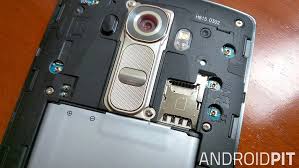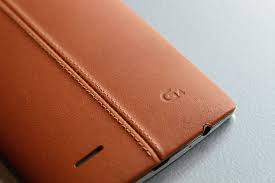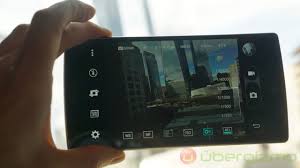review about LG G4
Hello i'm walid (the reviewer) today i will you talk about LG G4 :
2015 heralded the beginning of the end for plastic-bodied flagship smartphones. From the HTC One M9 to Samsung's Galaxy S6 handsets and even theHuawei P8, a full metal unibody became the de facto design for almost every top-end handset I saw that year. Except, it seems, on the LG G4.
2015 heralded the beginning of the end for plastic-bodied flagship smartphones. From the HTC One M9 to Samsung's Galaxy S6 handsets and even theHuawei P8, a full metal unibody became the de facto design for almost every top-end handset I saw that year. Except, it seems, on the LG G4.
Always keen to tear up the rulebook, LG's latest handset has gone full leather this time round, using genuine vegetable tanned, full grain cow hide on the rear of the phone. That's not the only thing that makes the G4 unique either, as its rear camera is the first to use a colour spectrum sensor that can supposedly read colours in exactly the same way as the human eye.
Of course, LG is widely expected to announce the LG G5 in the next couple of weeks, as this year's Mobile World Congress show is just round the corner. While it's not yet certain whether we'll see another leather-backed phone from LG, the G5 is widely expected to come with two screens, much like LG's newly-announced V10. We're also expecting a larger 20-megapixel camera sensor and Qualcomm's brand-new Snapdragon 820 chip to make an appearance as well.
That doesn't mean you shouldn't stop reading and wait for the G5, though, as the G4 is still an excellent phone in its own right. What's more, you can currently pick one up for just £300 SIM-free, or £27.50-per-month on contract, making it much cheaper than the likely launch price of the G5, which is likely to be around £500. It's also a great alternative to the Samsung Galaxy S5 Neo and Nexus 5X, particularly if you're looking for a smartphone that stands out from the crowd. And it's not just me who's a fan with Know Your Mobile also giving the handset a glowing review.

Design
The leather is certainly an intriguing choice of design, but I was pleasantly surprised by just how comfortable it felt. The stitching down the centre is a particularly classy touch, and the smooth tan leather option provided just as much grip as the stippled black version.
Measuring 149x75x8.9mm thick, it's not the slimmest of phones, but LG said that its customers were more than willing to sacrifice a few extra millimetres for a more ergonomic design – and I'd be inclined to agree. However, the leather cladding does add a considerable premium onto the handset. If leather isn't quite your bag, it's also available in cheaper 'ceramic and metallic' versions (both of which are really plastic).

They're still decent alternatives, as the ceramic model I had in for testing has a very subtle diamond-shaped pattern on the back of the handset. This adds a bit of visual flair to the phone when it catches the light, but in the hand it feels almost exactly the same as the plastic LG G3, making it a bit dull and tacky compared to the attention-grabbing leather versions. Having tested both models, I personally prefer the G4's curved leather rear.
The curve extends to the front of the screen as well, but the arc is so infinitesimally small that you'll barely even notice it unless you put the phone face down on the table. It's certainly nowhere near as curvy as the LG G Flex 2, but at least it should still help protect the screen if it happens to fall face down on the floor.

Display
The 5.5in 2,560x1,440 display was one of the stand-out features on the LG G3, so it's no surprise that LG has reprised this resolution for the G4. The resolution isn't quite as special as it once was, though, as both the Galaxy S6 and S6 Edge now have 2,560x1,440 resolution displays as well. What's more, they both have higher pixel densities of 576 pixels-per-inch (PPI) thanks to their smaller 5.1in screens, beating the G4's pixel density of 534PPI by quite some margin.

LG may not have the sharpest screen in the business any more, but its secret weapon is undoubtedly its brand new IPS Quantum panel. Not to be confused with LG's Quantum Dot technology used inside its TVs, the G4's screen uses a new type of liquid crystal that's meant to enhance brightness and overall colour accuracy.
In practice, the screen really does pop out at you when you first turn it on, showing lovely rich, vibrant colours and eye-searingly bright whites. Subjectively, it's almost comparable to the OLED display I saw on the G Flex 2 in terms of sheer colour intensity, but the G4 higher brightness level of 505.66cd/m2 really helps to keep those colours looking just as punchy both inside and out, particularly if you're out in the sun.

Blacks were deep at 0.27cd/m2 and we were suitably impressed with the G4's contrast levels, which LG says are supposedly 50% higher than those on the G3. This would certainly seem to be the case according to my own tests, as I measured a huge contrast ratio of 1,715:1, which beats the G3's measly 741:1 by quite some margin. Again, when I compared the G4 side by side with the G Flex 2, I could barely tell the difference in terms of image detail, which is good news for anyone still debating whether to go for this or a Galaxy S6, and the G4's viewing angles were just as wide as its curvier brother.
However, LG's boldest claim about the G4's display relates to its colour reproduction, and sadly that's not one I could back up during my calibration tests. According to LG, it's the only smartphone display that can reach 98% of the Digital Cinema Initiative (DCI) colour gamut, which covers a much wider range of colours than the traditional sRGB gamut, particularly when it comes to the number of shades of red.

LG says this equates to about 120% of the sRGB gamut, but our colour calibrator showed the G4 was only displaying 96.3% of the sRGB colour gamut. What's more, it was the G4's reds and yellows that fell short of the gamut boundary. Of course, 96.3% is still a highly respectable score for an IPS display, and it's easily one of the most subjectively pleasing screens I've seen outside of Samsung's Super AMOLED screens on the Galaxy S6 and S6 Edge, even if the nitty-gritty numbers (in my tests) don't quite live up to LG's promises.
thank you for reading don't forget to visiting my blog''ghwalid2.blogspot.com'' see you.
thank you for reading don't forget to visiting my blog''ghwalid2.blogspot.com'' see you.
Comments
Post a Comment